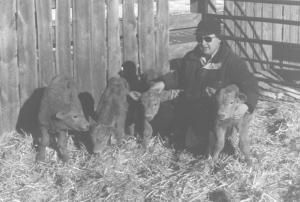2000 - Volume #24, Issue #2, Page #21
[ Sample Stories From This Issue | List of All Stories In This Issue | Print this story
| Read this issue]
Cow Produces Quadruplets Two Years in A Row
 |
According to Scotty Hofer of the Ponteix Hutterite Colony, the cow gave birth in early February to her second set of live quadruplets in as many years. Both times, the prolific cow calved naturally, although she has received some assistance during the births. All eight calves have been in the 35 to 45-lb. range.
Hofer says the 1999 calves included three heifers and one bull. Two of them nursed from the mother, while the other two were hand-fed. One of the heifers died at three weeks but the others survived.
This year, the Colony opted to leave only one calf on the cow, put another on a foster cow, and hand-feed the remaining two. All four survived.
The prolific mother began her career two years ago by producing twins û something that now appears to have just been a warm up for what was to come. Both sets of quads were sired naturally by a Charolais bull. No fertility drugs were involved.
Quadruplets are rare and most are stillborn. University of Wisconsin professor and animal geneticist Dr. Brian Kirkpatrick says research has found that there are also environmental influences in multiple births, in addition to genetic tendencies.
"We know that the time of year when breeding occurs can affect the number of multiple births, in addition to genetic tendencies. We also suspect there is a nutritional component whereby high nutrition prior to and at the time of breeding can increase ovulation."
Kirkpatrick is working together with cattlemen to establish a "breed registry" especially for cattle with highly prolific genetics.
"The registry will maintain records on the ancestry of animals as well as performance records. While most people don't look favorably on twinning because it can be a lot of extra trouble, there are people who desire this type of animal because of the increased profit potential. We have a mailing list of 65 cattlemen who are interested in increasing their twinning rate. So far, we know of 15 people who wish to participate in the registry and thereby become a potential source of seed stock."
For the past 20 years, twinning research has been going on at the USDA's Meat Animal Research Center at Clay Center, Nebraska. The center has established a herd of 300 cows that are genetically predisposed to twinning and the herd is currently achieving a 50 per cent twinning rate. The cows in this herd represent 12 different breeds.
The USDA has a production sale each year where they sell off excess stock produced by their prolific herd.
Contact: FARM SHOW Followup, Scotty Hofer, Ranch Cow Boss, Ponteix Colony, Box 37, Ponteix, Sask., Canada, S0N 1Z0 (ph 306 625-3652; fax 306 625-3251). Or contact Dr. Brian Kirkpatrick, Dept. of Animal Sciences, University of Wisconsin - Madison, 1675 Observatory Drive, Madison, Wis., 53706 (ph 608 263-4323; fax 608 262-5157; E-mail: kirkpat @calshp.cals.wisc.edu; Website: http://www.wisc.edu/animalsci/faculty/kirkpatrick. html).

Click here to download page story appeared in.

Click here to read entire issue
To read the rest of this story, download this issue below or click here to register with your account number.




